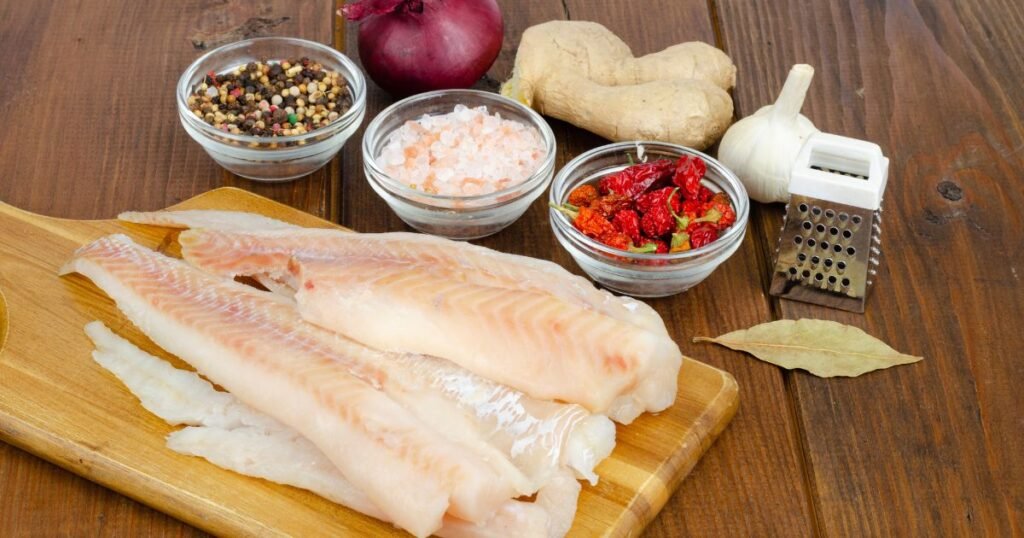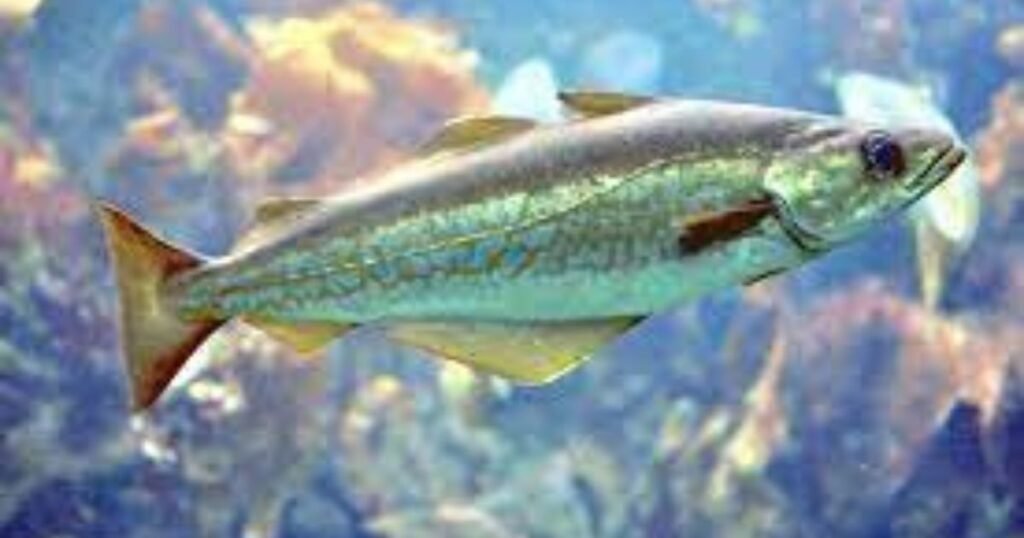Introduction
These species, Pollock fish, Pollachius pollachius, and Pollachius virens, are known for their elongated bodies, deep green coloration, and pale lateral lines. They are carnivorous, lively, and usually found in schools, growing up to 1.1 meters long and weighing up to 16 kilograms.

Habitat
Pollock fish are quite the travelers! They are found on both sides of the North Atlantic Ocean. In the western Atlantic, their favorite hangout spots are between Cape Cod and the Strait of Canso. At the same time, in the eastern Atlantic, they love to chill around Iceland, the North Sea, and off the northern coast of Norway.
When they’re just little fish, they prefer to stay in the shallow coastal zone for the first two years of their life. This is like their nursery, where they can hide and play among the rocks and macroalgae. But as they grow up, they crave adventure and move out into deeper waters, swimming in large schools throughout the water column.
Read More: Lion Headed Goldfish
Respiration
Like other fish, Pollock breathes through their gills. This is how they extract oxygen from the water to survive. They take water through their mouths, then push it out through their gills. As the water passes over the gill tissues, oxygen is absorbed into the bloodstream, and carbon dioxide, a waste product, is expelled into the water.
Fertilisation
The female Pollock releases her eggs into the water, and the male fertilizes them outside the body. This process is known as external fertilization. The number of eggs a female produces can vary. Still, some females can make several million eggs in a single season! It takes about a week or two for the eggs to hatch and the larval young to emerge.
Once the little ones are hatched, they start their life in the shallow waters, just like their parents did, and the cycle continues. Some Pollock begin to reproduce by age 3 or 4 and are highly fertile.
Read More: How Long Does Suboxone Stay in Your System
Pollock Fish Population
The Pollock fish population is sustainably managed and responsibly harvested under U.S. regulations. The Aleutian Islands, Eastern Bering Sea, and Western/Central/West Yakutat Gulf of Alaska stocks are not overfished. The Bogoslof and Southeast Gulf of Alaska population levels are unknown, but management measures are in place.

Pollock fish benefits for health
Yes, Pollock fish is good for you. It’s a nutrient-dense food that offers a host of health benefits. Some of these benefits include:
- Heart Health: The minerals found in Pollock positively impact blood pressure and circulation, reducing the risk of developing heart disease.
- Weight Loss: Pollock fish is low in calories compared to other protein sources, making it a good choice for those aiming for weight loss.
- Brain Health: The B vitamins found in Pollock have been linked to a decreased risk of dementia, depression, and insomnia. Omega-3 fatty acids, also present in Pollock, promote brain and mental health.
Pollock fish: Best source of nutrients
Well,it’s a good source of protein and is low in saturated fat. Pollock is also low in calories and a good vitamin B12, phosphorus, and selenium source. Other nutritional minerals in Pollock include calcium, iron, magnesium, potassium, sodium, zinc, and vitamin A.
Pollock’s high protein content and low fat and calorie count make it an excellent choice for those aiming for a healthier diet or weight loss. Plus, it’s loaded with omega-3 fatty acids known for their heart health benefits and anti-inflammatory effects.
Read More: Pollock Fish
Pollock has a mild, sweet flavor and a delicate, flaky texture. It’s less ‘fishy’ than other seafood options, making it an excellent choice for those who prefer a subtler taste. Its light flavor makes it versatile, pairing well with various seasonings and side dishes.
Why Pollock fish is Cheap?
Pollock fish, known as coalfish, Alaskan Pollock, Boston bluefish, saith, or harbor pollock, is among the most affordable seafood options available. This is primarily due to its abundance and the efficient methods used to catch it. Pollock is a semipelagic schooling fish. It tends to gather in large groups, making it easier for fishermen to acquire in bulk.
Moreover, Pollock is a fast-growing species with a relatively short lifespan of about 12 years. Some Pollock begins to reproduce by age 3 or 4 and are highly fertile, so each generation replaces aging or harvested fish in just a few years. This rapid reproduction and growth rate contribute to its plentiful supply and affordability.
How to Cook Pollock Fish
Pollock’s mild flavor and light texture make it a versatile ingredient in various dishes. It can be pan-fried, grilled, or baked, and its flavor makes it easy to pair with different side dishes[1].
Here are a few simple ways to prepare Pollock:
- Pan-Fried Pollock: Season the Pollock fillets with salt, pepper, and your favorite herbs. Heat some olive oil in a pan over medium heat, add the fillets, and cook for 3-4 minutes on each side until golden and flaky.
- Grilled Pollock: Marinate the Pollock fillets in a mixture of lemon juice, olive oil, garlic, and herbs for about 30 minutes. Preheat your grill to medium-high heat, then grill the fillets on each side for 3-4 minutes.
- Baked Pollock: Preheat your oven to 400°F (200°C). Place the Pollock fillets on a baking sheet, drizzle with olive oil, and season with salt, pepper, and favorite herbs. Bake for 10-12 minutes or until the fish flakes easily with a fork.
Remember, the key to a delicious Pollock dish is avoiding overcooking, which can dry the fish.

Is Pollock Freshwater or Saltwater?
Pollock is a saltwater fish. It’s widely distributed in the North Pacific Ocean, with the largest concentrations in the eastern Bering Sea.
Pollock vs. Cod
Pollock and Cod are members of the same family, Gadidae, and share many similarities. They both have a mild flavor, white flesh and are rich in protein and low in fat. However, there are some differences:
- Texture: Cod tends to have a firmer texture, while Pollock is more delicate and flaky.
- Flavor: While both have a mild flavor, Cod is often described as slightly sweeter.
- Nutrition: Both are nutritious, but Cod generally has a higher concentration of vitamins and minerals.
In conclusion, Pollock is a versatile, affordable, and nutritious seafood choice. Pollock is a fantastic option whether you’re looking for a protein-packed meal, a heart-healthy diet, or simply a delicious dinner. So why not give it a try? You might find your new favorite fish!






